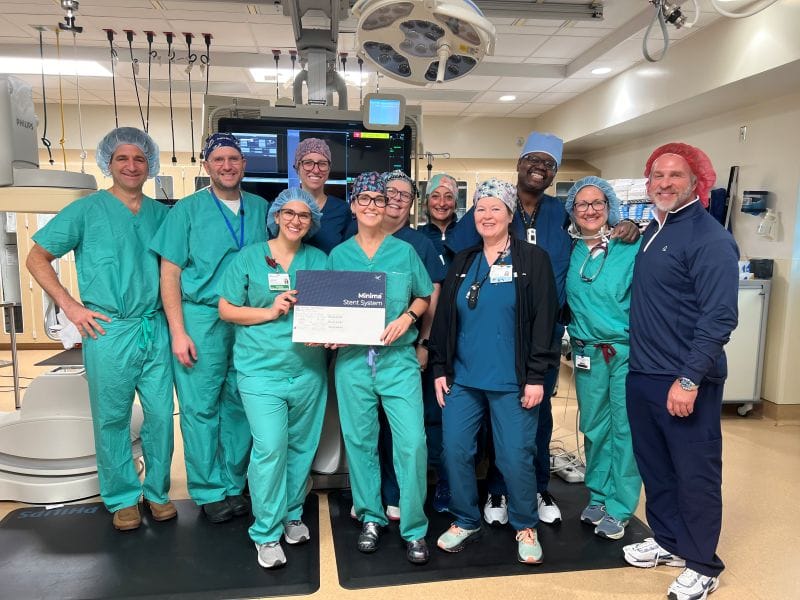One and Done: St. Joseph’s Children’s Hospital Pioneers a New Infant Cardiac Stent that is a Pediatric Game Changer
One of the best parts of Dr. Jeremy Ringewald’s job is, of course, saving lives. A pediatric cardiologist and the director of the cardiac catheterization laboratories at St. Joseph's Children's Hospital, Dr. Ringewald’s work is even more poignant because he works with the tiniest of patients.
But when you’re the parent of a newborn who has just received a potentially devastating diagnosis of a congenital heart condition, good news can come in many different forms. Thanks to a new technology that St. Joseph’s Children’s Hospital is helping to pioneer – a stent that is specifically built to enlarge the tiny blood vessels of newborns and babies – pediatric heart patients might now qualify for a one-and-done procedure.
“It is a total game changer,” says Dr. Ringewald. “This is the first stent approved to put in congenital heart patient infants, including newborn babies. It’s much smaller. Many patients that would have needed subsequent surgery will not. We can put it in smaller patients to avoid surgery at all.”
Recently, Dr. Ringewald performed the Minima stent procedure on 14-month-old Layla Lebovic, who was born with a complex cardiac condition that includes tetralogy of Fallot, pulmonary atresia and major aorto-pulmonary collaterals. This means she had a large hole between the bottom chambers of the heart, a missing connection between the right ventricle and main pulmonary artery and abnormal pulmonary artery branches.
During Layla’s procedure, Dr. Ringewald advanced several stents through a vein in her leg to her right pulmonary artery. Stents, Dr. Ringewald explains, are mesh tubes that keep arteries open and blood flowing. Until now, existing stents that were designed for larger children or adults had to be jerry-rigged to fit inside the blood vessels of a baby, resulting in stress on the heart and the complications of additional surgeries to put in new stents as they grew.
But the Renata Minima, the new stent that Dr. Ringewald used for Layla, is 1.3 millimeters in diameter, about the size of a cocktail straw. Its beauty lies in its geometry, which enables it to be inflated up to six times its original size without ever having to be removed and reinstalled.
The stent is mounted on a catheter, which has a balloon on one end. The whole apparatus is fed through a blood vessel, and when it’s in place, the balloon is inflated to deploy the stent, which can then fit into place snugly inside the blood vessel. Layla’s pulmonary artery was enlarged to five times its size. The procedure was a success, and Layla was discharged after only one day.
“We are so grateful to Dr. Ringewald and the entire St. Joseph’s Children’s Hospital cardiac team for the incredible care Layla received,” says Laura Lebovic, Layla’s mother. “She’s thriving and growing every day, and we’re so happy with the outcome of her procedure.”
“Growth is everything,” says Dr. Ringewald. “We want our patients to grow up, get well, be as well as they can be. The more that growth is factored in, the more safely, reliably, predictably we can get that tiny little person to adult size.”
Layla was only the 21st patient in the world to get a Renata Minima stent. For someone of that exact diagnosis, she was the first patient in the world. The Patel Children’s Heart Institute at St. Joseph’s Children’s Hospital is the first in the southeastern United States and one of only a handful of programs in the world to implant this stent.
“Two thirds of the things I do did not exist when I started practicing 25 years ago,” Dr. Ringewald says. “All these new advances change the way we look at all these diseases. If we’re doing the same thing five years from now, we’re five years behind. I get to tell patients all the time: ‘Here, we did this so your child does not need surgery.’ Every time I do that, it’s like Christmas morning. It’s this blessing. And boy, is it exciting.”
FEATURED IMAGE: Dr. Jeremy Ringewald (second from left), director of the cardiac catheterization laboratories at St. Joseph's Children's Hospital, and the congenital cardiac catheterization team celebrate the hospital's first Minima stent procedure.
READ MORE:
- Safety First: Baby Safety Tips from BayCare Kids Expert
- Performing Big Miracles: Cardiologists at St. Joseph’s Children’s
*Presented by BayCare | Originally published in the April 2025 issue of Tampa Bay Parenting Magazine.


